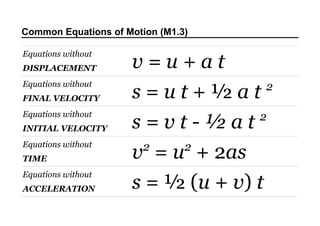Work and Energy
- 1. Common Equations of Motion (M1.3) Equations without DISPLACEMENT Equations without FINAL VELOCITY Equations without INITIAL VELOCITY Equations without TIME Equations without ACCELERATION v=u+at 2 s=ut+½at 2 s=vt-½at 2 2 v = u + 2as s = ½ (u + v) t
- 2. Momentum and Impulse (M1.4) Momentum Velocity and Mass Impulse Combining Momentum =mv =mv–mu For collisions.
- 3. Vectors in Mechanics – M1.2 Magnitude and direction of a vector. Vectors can be considered as triangles. You use SIN, COS and TAN to RESOLVE vectors to multiple dimensions, just as you'd use them for unknown lengths of sides. You can use the rules of Pythagoras to determine the magnitude of the RESULTANT. j θ i v2 = j2 + i2 j = v sin( θ ) the magnitude of the vector v resolving into dimensions
- 5. Kinematics of a Particle – M1.3 Motion in a straight line with constant acceleration. The gradient of a displacement-time graph is the VELOCITY. The gradient of a velocity-time graph is the ACCELERATION. The area under a velocity-time graph is the DISPLACEMENT. Example graph from Question: Knowledge and use of formulae for constant acceleration will be required. (Refer to Common Equations of Motion M1.3.)
- 6. Newton's Laws (M1.4) Newton's First Law. An object will not change its velocity until an unbalanced force acts upon it. Think 'frame of reference'. Newton's Second Law. f = ma Newton's Third Law. Every action has an equal and opposite 're-action'. Force (in Newtons) equals mass times acceleration. Image by 'Benjamin Crowell' of Wikipedia.
- 7. Single-dimension Dynamics of a Particle (M1.4) You should know: • Newton's Three Laws. • 1 Newton (mass times acceleration) is 1 kg m s -2. • Impulse, Momentum and applications (e.g. collisions). • Co-efficient of Friction: On a rough surface, with Co-efficient of Friction 0.7, the Friction can be determined with the equation Friction = 0.7 * Reaction. The object is not moving upwards, so Reaction is equal to Weight. R F = μR F=μR The Co-efficient of Friction, multiplied by the Reaction force equals the Friction. This applies to surfaces of uniform Friction.
- 8. Statics of a Particle (M1.5) - Friction acts opposite the resultant force. - Friction is always less than or equal to the resultant force. If this is the case, dimensions x and y will both resolve to 0. For instance; Reaction – (Mass * Gravity) = 0 Acting Force – Friction = 0 F≤μR Friction Sometimes it can be quicker to RESOLVE forces with a different frame of reference. For instance, perpendicular to a plane, so less forces have to be resolved. In practice, in equlibrium, Friction may not be EQUAL to c.o.fr. times reaction. When a particle is not moving, all of the FORCES acting upon it must be equal. Since all FORCES are VECTORS, they can be resolved per dimension.
- 9. Moments (M1.5) 10 N Fixed about point A and in equlibrium. A In the first diagram, the moment of force 'F' about point 'A' is F * d. The second diagram represents a couple. Across any direction, it resolves to nothing, so the object would rotate but not move. sm Moment = E*s 10 N EN M=F*s Moment = Force x Distance For some problems, you must also RESOLVE HORIZONTALLY, and for some just as moments. Moments in each direction (clockwise and anti-clockwise) are equal while in equilibrium. M(^) - M ( v ) = R(^)
- 10. Mechanical Models and Terms – M1.1 Particle A single object without specific structure or internal motion. Lamina Thin plate or layer. Rigid Body Size and shape are fixed definitely. Rod Inextensible Smooth/Rough No friction/subject to friction. Single-dimension lamina. Light No conceivable mass. Uniform Of a consistent density/structure. Cannot change in length. Pulley Adjusts direction of motion Bead Particle confined to wire. Wire Peg Inextensible string to which beads are confined. To fix within a certain range.










